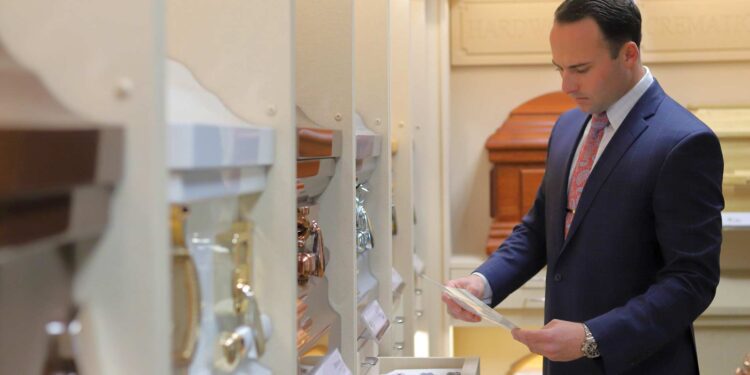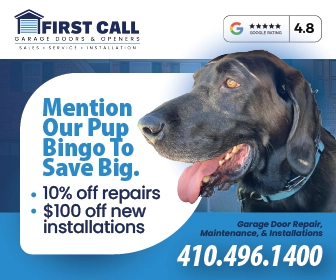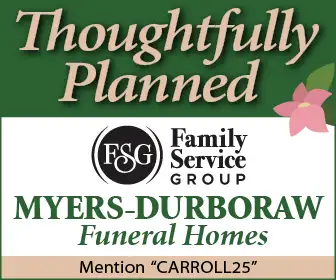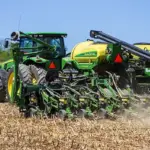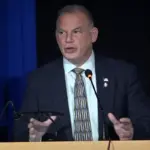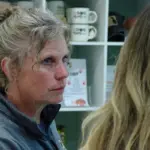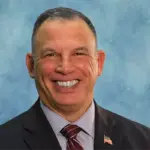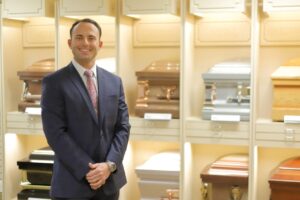
by Linda L. Esterson, photography by Nikola Tzenov
Connor Eline drove the flower car behind the hearse in a funeral procession headed out from Eline Funeral Home in Finksburg. About 50 cars followed in the slow-moving line proceeding to the cemetery. Suddenly, a detour stopped the cars in their tracks.
Punting as required, Connor pulled into a shopping center, and put on one of his many hats: traffic cop. As he directed the vehicles to U-turn, the deceased’s immediate family passed him and he was surprised to see them laughing. Upon arriving at the cemetery, the widow told him the detour was perfect. Her husband was never on time, refused to ask for directions and repeatedly got lost.
“They connected that as if he was kind of the bigger power, pulling the puppet strings to make things humorous,” Eline said.
Humor isn’t what you’d expect from funeral directors, but in light of what they deal with on a daily basis, it’s something that certainly helps.
With National Funeral Director and Mortician Recognition Day approaching on March 11, it’s appropriate to take a look into the work of professionals who handle the most difficult time for families. For funeral directors and morticians, the typical day is filled with uncertainty, and the job is far from what others call a desk job. It means abruptly canceling a vacation when someone in the community unexpectedly passes away, collecting the body, preparing for the funeral, supporting the family and running a large service.
For Eline, the day could start with the phone ringing at his bedside at 2 a.m. Springing into action, he dons a suit, rushing to the funeral home in Hampstead, Finksburg or Reisterstown to meet his father or another employee, to go to the location of the deceased. They gently comfort the family, take possession of the body and then return to the funeral home to begin preparations. By the time Connor is back home, it could be 4 a.m., and after a nap, he’s back at the office at 7 a.m. This time, he’s dressed in casual attire including steel-toed boots, pouring concrete for Eline Monuments, trying to get as many done as possible before the cold of winter causes the ground to freeze. He could be dressed just as casually to mow the grass, wash cars, clean bathrooms and vacuum. Later in the afternoon, he’s back in a suit, meeting with family members. He may change again to business casual attire when he’s working on arrangements, pulling down ceiling tiles and running wires to install video and audio equipment, or repairing a leg on an office chair.
“I’m in and out, from a suit to work clothes to business casual slacks and a button-down to a full suit every single day,” he laughs. “It’s probably two or three times a day that I’m changing clothes and cleaning up and then going out and being hands-on with our other businesses.”
The middle-of-the-night calls are usually handled by Connor or his father, Steven Eline, ensuring that a family member is involved.
“That that means the world to them,” Connor says. “It makes a difference for me because if I was on the other end of the phone and had just lost a loved one, that would mean a lot to me to have that same level of attention and care. Because it’s a trust thing.”
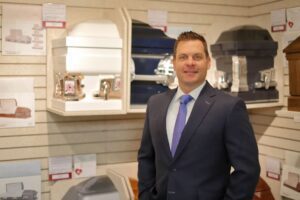
That trust and compassion is developed over time, experiencing all aspects of the business and dealing with families. Eline and Tom Fletcher, a third-generation funeral director with Fletcher Funeral & Cremation Services, both grew up in their family’s business, learning by example as their fathers ran the operations. Both, too, grew up living in an apartment above the funeral home.
Both earned undergraduate degrees in business prior to enrolling in the accredited mortuary science program at the Community College of Baltimore County, and both completed the required 1,000-hour apprenticeship at the family funeral home before sitting for the national board exam. Sydney Heinle, also a funeral director with Fletcher Funeral & Cremation Services, completed a high school internship with the company before earning a Bachelor of Mortuary Science degree from the Cincinnati College of Mortuary Science. In Maryland, all are certified as funeral directors and morticians, and approved to handle all operations of the business from embalming to burial.
The funeral directors meet with family members to make arrangements, whether immediately following a loss or years in advance to prepay expenses, and greet visitors who appear for services. But those aspects are just 1 percent of the job, according to Fletcher.
The job is primarily about getting dirty — preparing human remains, operating a crematory, and making removals at homes and residences, specifically following unexpected deaths, when the call comes in at 2 a.m. and the body is in the third-floor apartment without an elevator and it’s the middle of winter or a rainstorm. “And we do all of that in a suit,” Heinle says.
“You have to expect the unexpected,” says Fletcher about going into a home or care facility following a death. “You’re not sure how many family members are going to be there or if any family member is going to be there. … Some folks might be crying. They might be angry. So you have to console them while, at the same time, trying to see what kind of options they would like for their loved one.”
Once the body is at the funeral home, the embalming process begins. For the most part, it’s second nature. “It’s just part of your job, obviously the more you do it, the more experience you get, the better you get at your job,” Fletcher says. “But every case is different. If you’re working on a child or teenager, it can be a lot different than working on someone that’s 85 years old.” Injuries from accidents or gunshot wounds also demand more attention — and more of a need to not think about what happened.
During embalming, the body is disinfected and preserved. A service that is a week away in another state may necessitate a stronger chemical than a service that will occur in the building in the next few days, Heinle says. Determinants for selecting the material are the person’s age, pigmentation and how they died. The process, which includes draining the person’s blood and replacing it with the chemical fluid, produces a livelier color to the skin. Once the body is ready, the person is dressed. Usually the family provides the attire, whether a favorite outfit, Army or Navy uniform or even a wedding dress. If the clothing doesn’t fit, it is cut in the back to successfully lay on the body, Heinle said. The embalmer applies special mortuary-specific cosmetics and washes and dries the hair to make it look presentable. The full process can take from 45 minutes to eight hours.
Embalming is not the most difficult part of the job, Fletcher says. The hardest part is bringing cost into the conversation. The costs associated with a burial, cremation and a monument surprise many people.
“It’s not cheap to come into the world and it’s not cheap to leave the world,” he says. “We try to work with each family the best that we can.”
Families trust funeral directors to handle their loved ones with compassion and care. But they also know that these individuals are human and can feel the effects of a loss.
“I think in our area in Carroll County, especially with the family-owned funeral homes, we’re all extremely invested in our communities and families. When they’re talking with us, I think they value us being personal, being real,” says Eline. “If they see a funeral director smile, a lot of folks would [question it]. It’s just being genuine … being present. And that’s what I always try to do is, to be present, to be understanding, to be compassionate, and to be dignified.”
Despite the tough exterior, there are times when empathy takes over. Meeting with families immediately following a death or months later to work on a monument, can elicit personal feelings. Eline admits to tearing up at times.
“I also want people to know that I’m a human as well. And we all grieve, and that’s a part of compassion, and empathy, that I think so important in our in our line of work,” he says. “There are times that you might tear up and cry in front of a family, and there are plenty of times that you might walk away, and just need a moment. It’s hard to be the strong person every single time. But as with anybody, you learn to cope. Everyone grieves; you can’t be a vampire and turn off that switch.”
Eline feels a sense of responsibility as the sixth generation in the family business. Their community commitment is like a ministry, he says, with rewards that outweigh the lifestyle challenges, like the inability to disconnect on a vacation, the 24-hour availability and the stress associated with a high-profile funeral or one that followed a tragedy.
“The most rewarding part is just knowing that families can entrust not just in my father, my cousin and I, but also they can truly trust all of our team on the worst day of their lives,” he said. “For us to be there to assist them with something unexpected, it’s something that is cherished and something that’s valuable. And it’s something to never take for granted.”
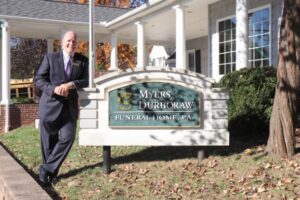
The Pandemic Impact
The coronavirus pandemic has wreaked havoc on businesses, and funeral homes are no exception.
According to Justin Durboraw, president/owner of Myers-Durboraw Funeral Home, the coronavirus resulted in more deaths than funeral homes would have seen in a normal year.
“A lot of people we have handled would not have passed,” he says. “They might have been ill or even in nursing homes or long-term care but they weren’t expected to pass.”
Durboraw calls his industry the “final responders in this pandemic,” with much of the same challenges as health care centers, especially when it comes to securing personal protective equipment (PPE) like gowns, masks and gloves.
“It’s very sad,” he notes. “I’ve never seen anything like it in my short career (since 1992).”
Physical processes have not changed, according to Sydney Heinle, funeral director at Fletcher Funeral & Cremation Services, as embalming has always been performed with the utmost precautions.
“We have always been taught to treat every body as if they have an infectious disease,” she says. “We always follow the same protocol. Maybe now we’re a little extra careful as far as putting extra equipment on. Some of us have added face shields and hair nets. We cover every inch of our bodies.”
Attendance limits for services, visitations and at cemeteries were decreased as the pandemic’s impact worsened, and funeral home operators were forced to make these events private. Some cemeteries limited attendance to just three people.
“The hardest part for us personally was when sitting down with a family to tell them, when they have a room full of children, that only one individual was allowed to come to the services,” Connor Eline of Eline Funeral Home says. “And it was very difficult to tell a grieving widow or widower that you and your four children are not able to come because the funeral director counts as one individual and the pastor, priest or rabbi counts, too, and that one family member makes three.” Some cemeteries did not allow people to watch from their cars.
“In my opinion, no one should ever be denied the right to grieve or to have a service. These abbreviated services were very difficult because they weren’t inclusive — they were exclusive. And not everybody has access to a computer to do webcasting or watch it online.”
Technology, Durboraw says, has been one positive result for his three facilities, as they added the capability to live stream services for those who cannot attend due to service and travel restrictions.
The pandemic has instigated an increase in cremations to the pandemic. In a normal year, Durboraw estimates about 45% of families opt for cremation. With the pandemic, that jumped to 60%, he says.
“I don’t see it ever going back,” explains Durboraw, who cites cost, ease and the limits to services as the most compelling reasons. “They figure, let’s just get Mom or Dad or Grandma or Grandpa cremated, and we’ll have a public memorial service when all of this COVID conditions are released…But I would venture to say the vast majority of those families that said they’re going to have a public memorial at a later date never will. The longer you get out from a person’s passing, the less likely… it’s like tearing off a band-aid.”
Tom Fletcher of Fletcher Funeral & Cremation Services hopes that people return to choosing open-casket viewing for family and friends, one of the most important aspects of end-of-life.
“It gives people a chance to say their final goodbyes, and for the family to come together,” he says. “Weddings and funerals are pretty much the only two times that you get to have your family together as one. It’s definitely important for people to come together for a service.” u


